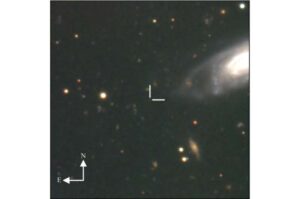
Recent simulations conducted by researchers at the Niels Bohr Institute, the University of Lisbon, and other institutions have provided new insights into the nature of black hole mergers. Their work suggests that these cosmic events may produce observable gravitational-wave tails, a phenomenon that could significantly enhance our understanding of the universe.
Black holes are regions of spacetime where gravity is so intense that not even light can escape. According to Einstein’s general theory of relativity, when two black holes merge, they emit gravitational waves—ripples in spacetime that can be detected by observatories on Earth. While the presence of late-time gravitational-wave tails has been theorized, it has not been conclusively demonstrated until now.
The team’s findings, detailed in a paper published in Physical Review Letters on November 13, 2025, indicate that these tails not only exist but may also have a larger amplitude than previously anticipated. This increased amplitude suggests that they could be detectable in future gravitational-wave experiments.
Significance of Gravitational-Wave Tails
Marina De Amicis, the lead author of the study, explained the importance of the tails. “When a deformed black hole—the product of a merger—relaxes back to equilibrium, it initially emits a superposition of defined vibrational frequencies,” she noted. This phase, known as the ringdown, is routinely observed in gravitational-wave data and is crucial for testing general relativity on small scales. However, De Amicis emphasizes that the ringdown is not the conclusion of the story.
Once the ringdown signal fades, the surrounding spacetime remains slightly distorted as it gradually returns to its original state. This process produces what is referred to as a ‘tail’, which could provide complementary information to the ringdown. “Tails open a new window into studying the large-scale structure of regions in our universe that contain black holes,” added De Amicis.
Advanced Simulations to Reveal New Insights
Previous studies had predicted the existence of gravitational-wave tails under simplified conditions. For example, perturbation theory suggested that small ripples would emerge around massive black holes. However, the current research aims to explore the complexities of Einstein’s equations in realistic scenarios involving merging black holes.
To achieve this, the researchers conducted numerical relativity simulations that solve Einstein’s equations. “There are two main challenges in detecting tails in numerical relativity simulations,” De Amicis stated. The first challenge arises from the typically weak nature of the tails, which can be obscured by numerical noise. To counteract this, the team focused on initial configurations that amplify the tail, specifically head-on collisions.
The second challenge involves the limited spatial coverage of numerical simulations, which can truncate the tail signals and create artifacts that obscure their detection. The researchers successfully extended the spatial coverage of their simulations, enabling them to accurately capture the tail within a time frame relevant for realistic observations.
Their findings suggest that gravitational-wave tails could be amplified during certain merger events, providing a new prediction that can be tested with upcoming gravitational-wave detectors. “This new signal carries imprints of gravity’s ability to interact with itself, a property known as nonlinearity,” De Amicis explained. Probing this nonlinear aspect of gravity is notoriously challenging, and the team’s discovery offers a novel method for studying it.
The implications of this research are significant. The simulations indicate that nonlinear effects could be detectable not only during the brief moments of black hole mergers but also for a considerable duration afterward. “We want to understand the nonlinear content of the late-time tail to see what this part of the signal can reveal about general relativity and the nature of our universe,” De Amicis added. The researchers are also keen to determine the observational conditions necessary for detecting these tail signals with current and future gravitational-wave observatories.
The work conducted by this team represents a significant advancement in our understanding of gravitational waves and black holes. As the field progresses, these findings could open new avenues for exploring the fundamental nature of our universe.







